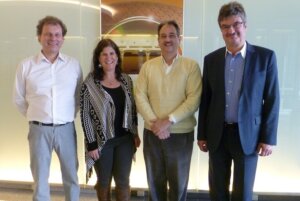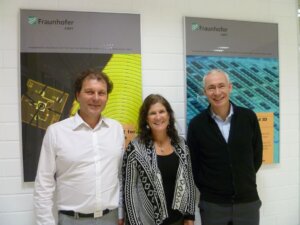 After so many years covering 3D technologies, I love finding a new angle to write about. Yesterday’s visit to Fraunhofer EMFT in Munich provided just that. Instead of focusing on 3D IC processes, we talked about 3D systems integration and the e-BRAINS project. And rather than discussing the well-worn topic of mobile applications, we talked about other markets that stand to benefit from 3D heterogeneous integration, such as medical devices and industrial applications.
After so many years covering 3D technologies, I love finding a new angle to write about. Yesterday’s visit to Fraunhofer EMFT in Munich provided just that. Instead of focusing on 3D IC processes, we talked about 3D systems integration and the e-BRAINS project. And rather than discussing the well-worn topic of mobile applications, we talked about other markets that stand to benefit from 3D heterogeneous integration, such as medical devices and industrial applications.
One of the reasons that 3D InCites tagline is “stirring up interest in 3D Integration” is because I’ve always felt that 3D technologies are about so much more than just 3D ICs. While many argue that to be “true 3D” requires copper-filled through silicon vias (TSVs) I believe 3D technologies include anything that takes improved performance and functionality into the third dimension, rather than using a planar approach. Turns out Peter Ramm, department head, heterogeneous system integration at Fraunhofer EMFT, agrees with me. We also both share disdain for the “2.5D” term. He’s a physicist, after all, and he says from a physics perspective, the term “2.5D” just doesn’t make sense. Ramm prefers the term “interposer technology”. But I digress…

Ramm spearheaded the EU-funded e-BRAINS project as a follow up to its predecessor, the eCUBE project. e-BRAINS stands for electronic Best Reliable Ambient Intelligent Nanosensor Systems (I’m pretty sure the e-BRAINS acronym came first, and what it stands for came second.) For my visit, he arranged interviews with Christoph Kutter, director of the Fraunhofer Institute, as well as his e-BRAINS colleagues (the brains behind e-BRAINS, if you will): Dr. Reinhard Pufall, expert on reliability at Infineon, and Maximillian Fleischer, Sr. principal expert research scientist, Siemens. Together, they filled me in on the projects focus and goals.
As Ramm explains it, while eCUBE focused on developing the 3D heterogenous integration processes, e-BRAINS focus is on how heterogenous integration and nano-sensor device technologies can be combined to bring new levels of performance to selected applications with market potential. Target applications include medical devices, automotive, ambient living, and wireless sensor systems. Ultimately, says Ramm, 3D ICs are the key enabler to 3D heterogenous systems integration.

The driving force behind it all is the Internet of Things (IoT) – which requires trillions of sensors to be interconnected wirelessly to collect data. Christoph Kutter knows this, and is fully invested in dedicating institute resources to support the IoT revolution. “There are more things connected today then there are people on the earth, and this is just the beginning,” he said, explaining that the biggest driver is efficiency in people and the use of resources. Efficiency is needed in every field. Whether we’re talking about energy consumption, feeding the 10B people on the earth, efficiency in homes, or in medical treatment, its all sensor driven. “I’m deeply convinced that this can only be done with the Internet of Things and sensors all around,” he said.
Unlike mobile consumer applications, e-BRAINS target applications are not as cost-sensitive, and are driven by performance, functionality, and miniaturization. And according to Pufall, reliability is key to the success of heterogenous integration for these applications, as the expected lifetime is much longer than mobile applications. Failures are not tolerated, and we’re looking at lifetimes in excess of 10-15 years, rather than the 2-year maximum of mobile products. While cost is not the biggest issue, it’s still something to consider, he added. “Reliability is the glue,” said Pufall. “We must understand the degradation mechanisms and why things behave mechanically. By the design and selection of materials, we can achieve high performance without increasing the cost.”
As an example of the many applications targeted by e-BRAINS, Fleischer talked about Siemens stakehold in the project, which is in the industrial application area – sensing for air quality monitoring in buildings to manage energy systems better. He said 50% of energy required to operate a building relates to the heating and cooling. This can be reduced by 25% by having well-equipped air-sensing information. We’re not talking about your grandparents’ climate control system for cooling and heating. These nano-sensors measure not just temperature, but also levels of carbon dioxide that can affect human physical performance – for example in classrooms or meeting rooms. Another interesting fact shared by Fleischer – 36% of greenhouse gasses come from buildings, not automotive!

All of this before lunch (which, by the way, was across the street at Villa Flora – Italian in name only. I sampled Munchener Schitzel – delicious!) I’ve barely scratched the surface of my visit to Fraunhofer, which included much more detail on the work being done there, as well as a tour of the cleanroom. So as is my usual practice, there is much more to come after I’ve had a chance to digest and sift through all the information. Next stop on the Europe in 3D tour is Schaerding, Austria, and a visit (third time is a charm!) to EV Group. ~ F.v.T.



















